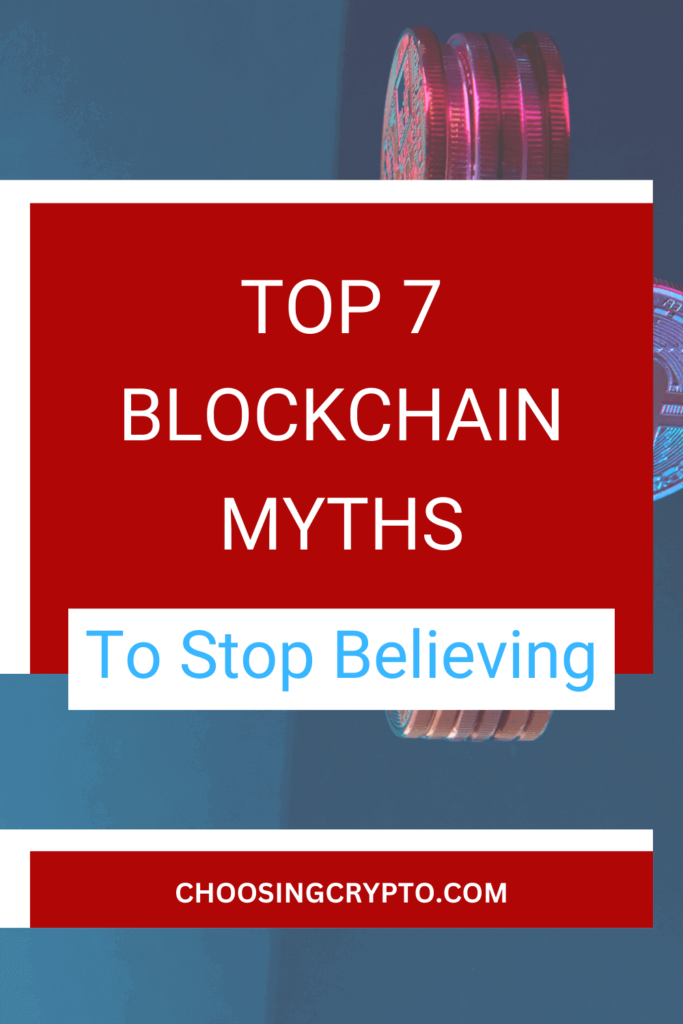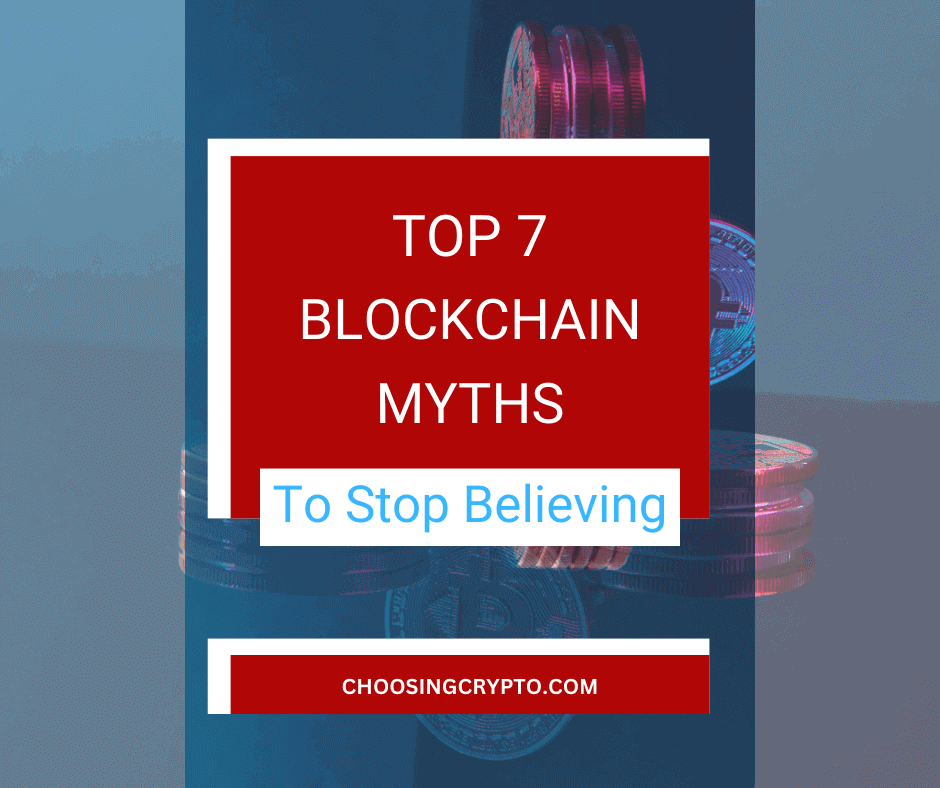Have you ever found yourself getting tangled up in all those blockchain myths?
Trust me, you’re not the only one.
Blockchain is a hot topic right now, surrounded by a mix of fascination and a fair bit of confusion.
But here’s the thing: hidden in all the excitement, there are loads of myths and misconceptions that just keep floating around without being questioned.
In this blog post, I’m going to dig into these blockchain myths. I’ll sort through all the noise and break down the 7 Top Blockchain Myths and Misconceptions that you shouldn’t buy into.
Get ready, because it’s time to challenge what you thought you knew.
IMPORTANT: I've selected some really great blog posts that I think you'll absolutely love. They're waiting for you right at the bottom of this post. Don't forget to give them a read!Myth 1: Blockchain is Only for Cryptocurrency
The myth that blockchain and cryptocurrency are inseparable twins couldn’t be further from the truth.
Yes, blockchain technology birthed the likes of Bitcoin and Ethereum, but its utility extends far beyond cryptocurrencies.
Reality Check:
1. Diverse Applications:
- Supply Chain Management: Blockchain ensures transparency and traceability in supply chains, preventing fraud and ensuring product authenticity.
- Healthcare: Patient records stored on a blockchain enhance security, accessibility, and interoperability among healthcare providers.
- Real Estate: Streamlining property transactions through smart contracts on blockchain reduces fraud and speeds up processes.
2. Smart Contracts:
- Decentralized Agreements: Smart contracts, self-executing code on the blockchain, automate and enforce agreements, eliminating the need for intermediaries.
3. Tokenization of Assets:
- Real-world Assets: Blockchain enables the creation of digital tokens representing real-world assets like real estate, art, or commodities, enhancing liquidity.
4. Social Impact:
- Transparent Donations: Charities can use blockchain to ensure transparency in donation tracking, providing donors with a clear view of fund allocation.
Why the Myth Persists:
Blockchain’s early association with cryptocurrency led to this misconception.
However, as technology evolves, its diverse applications continue to debunk the myth that blockchain is only for cryptocurrency.
Myth 2: Blockchain is Unhackable
While blockchain does have strong security features, it’s important to know that no system is completely immune to attacks.
Setting the Record Straight:
1. Immutable, Not Invincible:
- Blockchain’s Strengths: The immutability of data on the blockchain makes it resistant to tampering, enhancing trust.
- 51% Attacks: In certain scenarios, a malicious entity controlling over 50% of a blockchain’s computing power can compromise its integrity.
2. Smart Contracts Vulnerabilities:
- Code is Law, but Not Perfect: Smart contracts, while self-executing, are as secure as the code written. If there are Bugs or vulnerabilities in the code, they can be exploited.
3. Social Engineering:
- Human Element: Blockchain doesn’t protect against human error or manipulation. Users can still fall victim to phishing attacks and scams.
Why the Myth Persists:
Blockchain’s reputation for security excellence stems from its cryptographic foundations and decentralized nature.
However, overlooking potential vulnerabilities can create a false sense of invincibility.
Read Also: 7 Best Ways to Secure Your Cryptocurrencies
Myth 3: All Blockchains are the Same
The myth that all blockchains are exactly alike ignores the fascinating variety within this groundbreaking technology.
In truth, there are different types of blockchains, each designed for specific needs and uses.
Unveiling the Diversity:
1. Public Blockchains:
- Decentralized and Open: Public blockchains, like Bitcoin and Ethereum, are open to everyone and maintained by a distributed network. All transactions are transparent and accessible to everyone.
2. Private Blockchains:
- Restricted Access: Private blockchains limit access to a select group, often within a single organization. The focus here is on keeping things private and under control, rather than decentralization.
3. Consortium (Federated) Blockchains:
- Best of Both Worlds: A middle ground between public and private, consortium blockchains are operated by a group of organizations. They offer controlled access while maintaining decentralization.
4. Permissionless vs. Permissioned:
- Access Control: Permissionless blockchains, like Bitcoin, allow anyone to participate. Permissioned blockchains restrict access to a defined group, ensuring a higher level of control.
5. Use Case Specialization:
- Industry-Specific Blockchains: Some blockchains cater to specific industries, optimizing features for their unique requirements. For example, healthcare-focused blockchains prioritize data security and interoperability.
Overcoming Perception:
The misconception that all blockchains are the same often comes from linking them too closely with cryptocurrencies.
To really get it, it’s crucial to see the differences between public, private, and consortium blockchains.
Myth 4: Blockchain is Anonymous
People often think of blockchain as a secret hideout where users can do things in complete anonymity.
But it’s not that simple – blockchain actually gives us transparency, not total anonymity.
Unveiling the Truth:
1. Pseudonymous Transactions:
- Address Transparency: While blockchain transactions don’t directly reveal personal identities, they link to unique alphanumeric addresses.
- Pseudonymity Defined: Users operate under pseudonyms, offering a layer of privacy but not complete anonymity.
2. Traceability of Transactions:
- Immutable Ledger: Once a transaction is recorded on the blockchain, it remains there permanently. Every transaction is traceable back to its origin.
3. Regulatory Compliance:
- Anti-Money Laundering (AML) and Know Your Customer (KYC): Crypto exchanges and services often require user identification to comply with legal regulations, linking real-world identities to blockchain transactions.
4. Privacy Coins as an Exception:
- Specialized Solutions: Some cryptocurrencies, like Monero and Zcash, focus on enhanced privacy features, aiming to provide a higher level of anonymity.
Why the Myth Persists:
The confusion arises from the misinterpretation of blockchain’s pseudonymous nature and the association of privacy coins with the broader blockchain ecosystem.
Myth 5: Blockchain is Energy-Inefficient
Lots of people think that blockchain is really bad for the environment because it uses up so much energy.
This idea mainly comes from the way some blockchains, like Bitcoin, work.
But it’s important to know that not all blockchains are the same, and people in the industry are working hard to fix the energy problem.
Setting the Record Straight:
1. Proof-of-Work vs. Proof-of-Stake:
- Proof-of-Work (PoW): This is the old-school way that needs loads of energy. With Bitcoin, miners have to solve tricky maths problems, which use up loads of power.
- Proof-of-Stake (PoS): Here’s a different way that doesn’t need so much energy. Instead of solving puzzles, validators are chosen based on how much cryptocurrency they have and are willing to ‘stake.’
2. Ethereum’s Transition:
- Ethereum 2.0: Ethereum, the second-biggest cryptocurrency, switched from PoW to PoS to cut down on energy use.
- Layer 2 Solutions: These are ways to make transactions faster without using too much energy.
3. Comparing Energy Usage:
- Traditional Banking: Studies suggest that regular banks use up just as much or even more energy than some blockchains.
- Continuous Improvements: Ongoing research and innovations seek to enhance the energy efficiency of blockchain networks.
Why the Myth Persists:
The myth that blockchains are terrible for energy mainly comes from big cryptocurrencies like Bitcoin using PoW. Creating a generalized perception that overlooks the broader spectrum of blockchain technologies.
Myth 6: Blockchain is Just a Fad
Blockchain has faced its fair share of doubters, with some thinking it’s just a passing trend.
But if we take a closer look, we’ll see that blockchain is not just a fad; it’s a transformative force, reshaping industries and becoming a big part of our digital future.
Evidencing Longevity:
1. Mainstream Adoption:
- Global Industries: From finance to healthcare and supply chain, industries worldwide are incorporating blockchain for efficiency, security, and transparency.
- Corporate Giants: Major corporations are investing in blockchain, recognizing its potential for innovation and competitive advantage.
2. Continued Growth:
- Market Expansion: The blockchain market continues to expand, with a diverse range of applications and solutions emerging.
- Startups and Innovation: The proliferation of blockchain startups and ongoing innovations highlight sustained interest and investment.
3. Regulatory Acceptance:
- Legitimization: Governments and regulatory bodies are increasingly acknowledging and developing frameworks for blockchain adoption.
- Legal Recognition: Blockchain-based contracts and transactions gain legal recognition in various jurisdictions.
4. Decentralized Finance (DeFi):
- Financial Revolution: The rise of DeFi platforms demonstrates how blockchain is disrupting traditional finance, offering decentralized alternatives.
- Smart Contracts: The automated and trustless nature of smart contracts continues to attract attention and investment.
Why the Myth Persists:
Blockchain’s early association with cryptocurrencies and the initial hype cycle contributed to the perception of it being a temporary trend.
But now that we’re seeing how useful it can be, we can tell it’s here to stay.
Myth 7: Smart Contracts are Flawless
Smart contracts, the self-executing code on a blockchain, are often hailed as flawless, eliminating the need for intermediaries.
However, it’s crucial to recognize that smart contracts, while powerful, are not immune to vulnerabilities and require careful consideration.
Debunking the Overconfidence:
1. Code Vulnerabilities:
- Smart Contract Bugs: Like any code, smart contracts can contain bugs or vulnerabilities that can be taken advantage of.
- Immutability Challenges: Once a smart contract is up on the blockchain, correcting errors is like fixing a typo in a book that’s already published.
2. Security Risks:
- Oracle Manipulation: External data sources (oracles) can be manipulated, leading to inaccurate outcomes.
- Front-Running: Malicious actors may exploit timing differences in transaction execution, affecting the intended outcome.
3. Complexity and Auditing:
- Complexity Challenges: As smart contracts become more complex, auditing them thoroughly becomes increasingly challenging.
- Human Error: If the developer writing the smart contract makes a mistake, it could lead to some pretty big problems.
Why the Myth Persists:
Some people think smart contracts are flawless because they trust that the code will always do what it’s supposed to do.
But here’s the catch – if we don’t pay attention to the possible problems, things might not turn out the way we want them to.
Additional Resources:
Excited to learn more about Bitcoin and cryptocurrencies? We’ve got some awesome resources below to help you out.
- What Exactly is Blockchain Technology? A Beginner’s Guide
- 7 Misconceptions about Bitcoin to Stop Believing
- What Are Smart Contracts and How They Work
- 10 Less-Known Facts about Bitcoin
- 20 Things You Should Never Do as a Crypto Investor/Trader
And guess what? We’re also on Instagram and Twitter(X). Join us there for even more fun and useful content!

DISCLAIMER:
The information provided here is intended for informational purposes only and should not be solely relied upon for making investment decisions. It does not constitute financial, tax, legal, or accounting advice. Additionally, I strongly recommend that you only invest in cryptocurrency an amount you are comfortable with potentially losing temporarily.
Read Also: How to Research a Crypto Project Properly Before Investing
